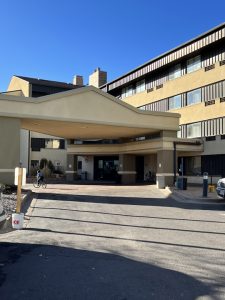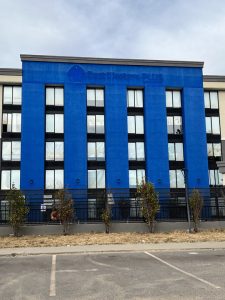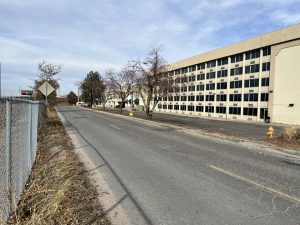Finding Shelter
Northeast Denver To Host Majority Of People Coming Off The Streets In Mayor Mike Johnston’s House1000 Initiative
By Cara DeGette
GPHN Editor

As Mayor Mike Johnston makes a mad dash toward his self-imposed finish line to find shelter for 1,000 unhoused people by the end of the year, northeast Denver and Park Hill have emerged as the destination for almost all of them.
It hasn’t been a smooth ride for the new mayor or the rollout of his signature program to address the city’s homeless crisis.
In recent weeks, members of the city council have publicly vented their frustration and distrust at Johnston and his administration. Councilwomen Stacie Gilmore and Flor Alvidrez have been particularly vocal. They’ve complained about a lack of transparency and accountability, mixed with chaos and confusion over which of the mayor’s chosen housing sites are moving forward, and which are on hold.
They, and others, have expressed frustration, distrust and disgust at the way the mayor’s office has communicated — and not communicated — their plans for new housing sites. Denver’s point-in-time count this year showed 5,818 people experiencing homelessness, with 1,423 of them unsheltered and living on the streets.
Johnston’s goal is to house 1,000 people and permanently close unsanctioned encampments by the end of 2023. At the end of November, 292 people have been housed, leaving the mayor with 708 people to shelter to meet his year-end goal.
The mayor has said that housing will be evenly distributed throughout the city — which has not happened. Instead, the majority of the planned sites are in economically disadvantaged areas, in and near Northeast Park Hill, which Gilmore and others say further concentrates poverty in already vulnerable neighborhoods.
These are the announced sites in and near Park Hill (see the story sidebar below for details, as well as a list of additional existing facilities):
• The DoubleTree: 4040 Quebec St. — 450 individuals (plus 75 during cold weather)
• The Best Western: 4595 Quebec St. — 136 individuals (plus 75 during cold weather)
• The Comfort Inn: 4685 Quebec St. (open since February): 138 families
• The Stay Inn: 12033 E. 38th Ave. — 95 households

At one November council committee meeting. Cole Chandler, the mayor’s director of homelessness initiatives, said the city is actively seeking additional hotels and other sites. Chandler also said that in areas where the highest saturation has occurred (including Park Hill and northeast Denver), the city has “engaged the community deeply.” That comment drew a rebuke from Gilmore, who called such claims “not accurate.”
Shortly before Thanksgiving, Gilmore resigned as the chair of the city council’s committee on Safety, Housing, Education & Homelessness, saying she no longer trusts the administration. Gilmore’s district encompasses the far northeast area of the city.
Outside of northeast Denver, two micro-communities are under construction — including at 1375 Elati St. and 2301 S. Santa Fe Dr. Combined, the sites will house about 100 people. And, another former hotel on Hampden Avenue in southeast Denver is currently under consideration. It has about 200 rooms.
Many people living in communities that will absorb the biggest impacts — especially in Northeast Park Hill and nearby Central Park — have also expressed frustration.
Councilwoman Shontel Lewis, whose District 8 includes Northeast Park Hill, says she is not happy that the neighborhood is being forced to do the heavy lifting. But not pushing forward, she says, is not an option.
“I’m concerned about the concentration of poverty,” Lewis said. “I am also concerned there are people who need shelter in our community and many are from our community and we need to do something about it.

“People are losing their lives and their limbs. I don’t sleep at night, honestly, when I think about the people who are on our streets as the weather gets colder and colder.”
Meanwhile, as plans move ahead to open facilities in and around Park Hill, several proposed smaller projects in wealthier neighborhoods have been nixed. Those include micro-communities in southeast Denver at 1380 S. Birch St. and 5500 E. Yale Ave., and 1151 Bannock St in the Golden Triangle neighborhood south of downtown. City officials say the sites ended up having too many logistical challenges.
At a November town hall meeting at Martin Luther King, Jr. Recreation Center, Johnston said the Park Hill sites were picked in large part because of their proximity to transit, including light rail. However, the infrastructure in the area is challenging at best. Many sidewalks do not connect, for example, and some don’t exist.
Members of the city council have also raised questions about whether the current plans for “wraparound services” — from mental health and medical services to job training — are realistic given the likely demands. Other questions over basics have been raised, including access to food. What impact will the increased pressures have on already overwhelmed neighborhood food banks?

Others wondered whether the mayor plans to add additional police and public safety resources.
“The most dangerous thing we can do in Denver is what we’ve been doing the last 10 years,” Johnston said during the public meeting at the MLK, Jr. Recreation Center. “What we know is when we do put people into wraparound services and enforce rules, we have dramatically different outcomes.”
Several neighbors said they absolutely support programs that provide more permanent homes and services — but they do not support concentrating poverty in one area.
“I get that we need to do our fair share,” said one speaker. “But 900 units? That’s over-saturation. What we need to really talk about is, how are we fairly distributing this across the city?
“We really need to think about the impact that this will have on this neighborhood that already has multiple issues for multiple generations.”
But Councilwoman Lewis was unbowed. “We have to move forward. What’s in my heart and what’s important to me is not having people need food, [not losing] their lives and their limbs.”

The New Digs
A Breakdown Of New And Existing Facilities In The Neighborhood
These former hotels in Park Hill and just beyond the neighborhood’s borders are included in Mayor Mike Johnston’s Housing1000 initiative. They include:
The Best Western (now called New Directions): 4595 Quebec St.
Sandwiched between Interstate 70 and Interstate 270. For orientation, imagine the Sapp Bros. truck stop, with its huge neon coffee pot sign, on the west side of the road, and the exit to Northfield on the east side. The Best Western is near the Sapp Bros. on the west side. It will be operated by the Salvation Army. Three-fourths of the rooms have kitchenettes, which makes converting them to apartments less costly. Until the apartments are fully converted, they will be used for non-congregate shelter (meaning private rooms). In addition to the private rooms, the hotel’s ballroom may be used as a weather overflow shelter. Capacity: 136 individuals plus 75 during cold weather = 211 people
The DoubleTree: 4040 Quebec St.
For orientation, the former hotel is on the east side of Quebec Street next to Interstate 70. It’s north of railroad tracks that separate it from a Walmart and Home Depot. The facility will be operated by the Salvation Army. When it is up and running, it will serve as a 24/7 shelter with supportive services for up to 450 people in 289 units. The former ballroom may be used for weather overflow to shelter another 75 people.
On Oct 31, the state’s Department of Local Affairs announced a $24 million grant to Denver for the DoubleTree to serve as the hub for Denver’s three-site Navigation Campus to provide support services at this facility — not just housing. The other facilities that will be part of the Navigation Campus include the Best Western and the Stay Inn (see below). As of press time it is unclear how people in the other facilities will access services and how the “campus” will be connected. For example, though the Best Western is less than a half mile away, the hotels are separated by an interstate and the existing sidewalks do not connect. The third building — the Stay Inn — is more than three miles away and access is equally difficult. Capacity: 450 plus 75 sheltered during cold snaps = 525 people
The Stay Inn: 12033 E. 38th Ave.
The city approved the purchase of the former hotel at 38th and Peoria Street in January for $9 million. Officials said they hoped to have the facility open and operating by the end of this year. In late November, however, the property remains fenced off, heavy equipment is on site and all the windows are boarded up. No operator has been announced for this facility, which still requires a rezoning. Capacity: Housing for 95 households
Existingmshelter and transitional housing programs in and around Park Hill:
• Comfort Inn: 4685 Quebec St. — next to the Best Western hotel, near Sapp Bros. truck stop. 138 families are currently living here. It is operated by the Salvation Army.
• Fusion Studios: 3737 Quebec St. — 139 units of permanent housing with support services owned by Colorado Coalition for the Homeless.
• Denver Rescue Mission: 4600 E. 48th Ave. — Men’s shelter, capacity 515
• Samaritan House: 4330 E. 48th Ave. — Women’s shelter, capacity 270
— Cara DeGette
The Mayor’s House1000 Plan
Community Meeting Set For Dec. 7 in Park Hill
Park Hill Congregational UCC is hosting an all-community meeting on Mayor Mike Johnston’s homeless initiative on Thursday, Dec. 7.
Cole Chandler, the director of homelessness initiatives for the mayor’s office, is scheduled to discuss the city’s plans for sites in the neighborhood and elsewhere in Denver. A question & answer session will follow.
The community meeting is from 7-8 p.m., and everyone is welcome. Park Hill Congregational UCC is at 2600 Leyden St.
